| Listing 1 - 10 of 15 | << page >> |
Sort by
|
Book
ISBN: 089573494X 3527264671 Year: 1987 Publisher: Weinheim : VCH Publishers,
Abstract | Keywords | Export | Availability | Bookmark
 Loading...
Loading...Choose an application
- Reference Manager
- EndNote
- RefWorks (Direct export to RefWorks)
Oxidation. --- Addition reaction --- Alkylation --- Catalysis --- Reduction (chemistry) --- Transition state structure --- Addition reaction --- Alkylation --- Catalysis --- Reduction (chemistry) --- Transition state structure
Book
Year: 1987 Publisher: München : Friedrich-Alexander-Universität Erlangen-Nürnberg,
Abstract | Keywords | Export | Availability | Bookmark
 Loading...
Loading...Choose an application
- Reference Manager
- EndNote
- RefWorks (Direct export to RefWorks)
Chemical kinetics. --- Epoxy resins --- Isocyanates --- Nuclear magnetic resonance --- Spectroscopic analysis --- Amines --- Addition reaction --- Epoxy resins --- Isocyanates --- Nuclear magnetic resonance --- Spectroscopic analysis --- Amines --- Addition reaction
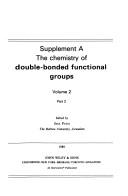
ISBN: 0471917192 0471924938 0471924946 Year: 1989 Volume: A Publisher: Chichester Wiley
Abstract | Keywords | Export | Availability | Bookmark
 Loading...
Loading...Choose an application
- Reference Manager
- EndNote
- RefWorks (Direct export to RefWorks)
Physical organic chemistry --- Chimie organique physique --- Addition reaction --- Cycloaddition reaction --- Elimination reaction --- Spectroscopy
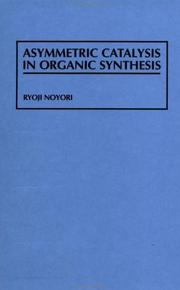
ISBN: 0471572675 Year: 1993 Publisher: New York, NY : John Wiley,
Abstract | Keywords | Export | Availability | Bookmark
 Loading...
Loading...Choose an application
- Reference Manager
- EndNote
- RefWorks (Direct export to RefWorks)
ASYMMETRIC SYNTHESIS --- HYDROGENATION --- ALKENES --- ISOMERIZATION --- TRANSITION METAL COMPLEXES --- CARBONYL COMPLEXES --- ADDITION REACTION --- PROSTAGLANDINS --- CATALYSIS --- REACTIONS --- PREPARATION --- ASYMMETRIC SYNTHESIS --- HYDROGENATION --- ALKENES --- ISOMERIZATION --- TRANSITION METAL COMPLEXES --- CARBONYL COMPLEXES --- ADDITION REACTION --- PROSTAGLANDINS --- CATALYSIS --- REACTIONS --- PREPARATION
Book

ISBN: 0471937495 9780471937494 Year: 1972 Publisher: New York, N.Y. John Wiley & Sons
Abstract | Keywords | Export | Availability | Bookmark
 Loading...
Loading...Choose an application
- Reference Manager
- EndNote
- RefWorks (Direct export to RefWorks)
Descriptive organic chemistry --- Organic compounds --- Synthesis --- Chemistry, Organic. --- Synthesis. --- Hydrogenation. --- Organic compounds. --- Oxidation. --- Organic compounds - Synthesis --- Addition reaction --- Deuteration --- Halogenation --- Rearrangement (chemistry) --- Substitution
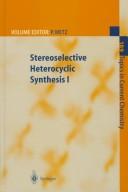
ISBN: 3540627006 3540684476 9783540627005 Year: 1997 Volume: 190 Publisher: Berlin Springer
Abstract | Keywords | Export | Availability | Bookmark
 Loading...
Loading...Choose an application
- Reference Manager
- EndNote
- RefWorks (Direct export to RefWorks)
This volume presents exciting new developments in preparative heterocyclic chemistry with a special emphasis on the stereoselective synthesis of - or with the aid of - heterocycles. A wide range of modern methods and strategies for the construction and synthetic elaboration of versatile heterocycles is surveyed in depth by leading researchers in this field. Due to the high quality and up-to-date coverage of each chapter, this volume provides a valuable overview of the different aspects discussed and will at the same time be highly inspiring for the expert synthetic organic chemist as well as the non-specialist reader.
Heterocyclic compounds. --- Stereochemistry. --- Heterocyclic compounds --- Synthesis. --- Chemistry. --- Organic chemistry. --- Organic Chemistry. --- Organic chemistry --- Chemistry --- Heterocyclic compounds - Synthesis. --- HETEROCYCLIC COMPOUNDS --- RING OPENING --- NUCLEOPHILIC ADDITION REACTION --- CHIRAL SYNTHONS --- STEREOSELECTIVE SYNTHESIS (NATURAL PRODUCTS CHEMISTRY) --- PREPARATION
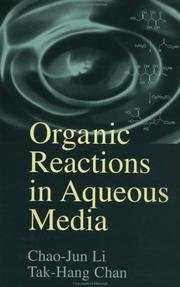
ISBN: 0471163953 Year: 1997 Publisher: New York, NY : John Wiley,
Abstract | Keywords | Export | Availability | Bookmark
 Loading...
Loading...Choose an application
- Reference Manager
- EndNote
- RefWorks (Direct export to RefWorks)
Chemical reactions. --- Chemistry, Organic. --- Solution (Chemistry) --- Basic Sciences. Chemistry --- Organic Chemistry --- Solution (Chemistry). --- Organic Chemistry. --- ORGANIC COMPOUNDS --- SOLUTIONS --- WATER --- ORGANOMETALLIC COMPOUNDS --- CYCLOADDITION REACTION --- NUCLEOPHILIC ADDITION REACTION --- OXIDATION --- REDUCTION --- REACTIONS --- PROPERTIES
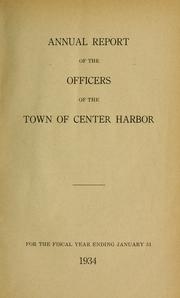
ISBN: 0198503075 9780198503071 Year: 1999 Volume: 67 Publisher: Oxford : Oxford University Press,
Abstract | Keywords | Export | Availability | Bookmark
 Loading...
Loading...Choose an application
- Reference Manager
- EndNote
- RefWorks (Direct export to RefWorks)
fysicochemie --- Organic reaction mechanisms and kinetics --- Addition reactions --- Ring formation (Chemistry) --- Stereochemistry --- #WSCH:LOSH --- 541.124:547 --- 541.124:547 Chemical dynamics in general. Reaction mechanism in general-:-Organic chemistry --- 541.124:547 Limits of reactions-:-Organic chemistry --- Chemical dynamics in general. Reaction mechanism in general-:-Organic chemistry --- Limits of reactions-:-Organic chemistry --- Atoms --- Molecular asymmetry --- Chemical structure --- Chemistry --- Isomerism --- Polarization (Light) --- Cyclization (Chemistry) --- Cycloaddition --- Exo-condensation --- Chemical reactions --- Space arrangement --- Organic cyclic compounds --- Cycloaddition reaction --- Ene addition reaction --- Rearrangement (chemistry)
Book
Year: 2022 Publisher: Basel MDPI - Multidisciplinary Digital Publishing Institute
Abstract | Keywords | Export | Availability | Bookmark
 Loading...
Loading...Choose an application
- Reference Manager
- EndNote
- RefWorks (Direct export to RefWorks)
This Special Issue on carboranes is dedicated to Prof. Alan Welch on the occasion of his retirement and his outstanding contributions to the field of carborane chemistry. Polyhedral carboranes lie at the interface of organic and inorganic chemistry. One of their most attractive and important features is the variety and beauty of their chemical structures. They have found applications as diverse as catalysis, in Boron Neutron Capture Therapy, as liquid crystals and as semiconductors. This Special Issue illustrates the very comprehensive world of heteroborane chemistry, from liquid crystals to BNCT agents, di-halogen bonding to quantum chemical calculations of tetrel complexes of the carbonium ylide CB11H11, nickellacarboranes as potential acid–base sensors to revealing how the selective formations of metallacarborane diastereomers can arise and metallacarboranes as function as radical cation salts with dielectric or semiconductor properties.
Research & information: general --- carboranes --- DFT --- reaction pathways --- boron chemistry --- o-carborane --- sulfa-Michael addition reaction --- cysteine --- boron neutron capture therapy --- o-carborane decapitation --- labeled compound --- 1,1′-bis(o-carborane) --- deboronation --- metalation --- bis(nickelation) --- diastereoisomers --- stereospecific --- boron clusters --- liquid crystals --- fluorescence --- cholesterol --- nido-carborane --- nitrilium derivatives --- nickel(II) half-sandwich complexes --- synthesis --- structure --- Lewis acid --- carborane --- carbonium ylide --- tetrel bond --- quantum chemistry --- electron density --- ELF --- iodo derivatives --- dihalogen bond --- X-ray structure --- quantum chemical calculations --- iron bis(1,2-dicarbollide) --- chromium bis(1,2-dicarbollide) --- tetramethyltetrathiafulvalene --- tetramethyltetraselenafulvalene --- radical-cation salts --- crystal and molecular structure --- electric conductivity --- n/a --- 1,1'-bis(o-carborane)
Book
Year: 2022 Publisher: Basel MDPI - Multidisciplinary Digital Publishing Institute
Abstract | Keywords | Export | Availability | Bookmark
 Loading...
Loading...Choose an application
- Reference Manager
- EndNote
- RefWorks (Direct export to RefWorks)
This Special Issue on carboranes is dedicated to Prof. Alan Welch on the occasion of his retirement and his outstanding contributions to the field of carborane chemistry. Polyhedral carboranes lie at the interface of organic and inorganic chemistry. One of their most attractive and important features is the variety and beauty of their chemical structures. They have found applications as diverse as catalysis, in Boron Neutron Capture Therapy, as liquid crystals and as semiconductors. This Special Issue illustrates the very comprehensive world of heteroborane chemistry, from liquid crystals to BNCT agents, di-halogen bonding to quantum chemical calculations of tetrel complexes of the carbonium ylide CB11H11, nickellacarboranes as potential acid–base sensors to revealing how the selective formations of metallacarborane diastereomers can arise and metallacarboranes as function as radical cation salts with dielectric or semiconductor properties.
carboranes --- DFT --- reaction pathways --- boron chemistry --- o-carborane --- sulfa-Michael addition reaction --- cysteine --- boron neutron capture therapy --- o-carborane decapitation --- labeled compound --- 1,1′-bis(o-carborane) --- deboronation --- metalation --- bis(nickelation) --- diastereoisomers --- stereospecific --- boron clusters --- liquid crystals --- fluorescence --- cholesterol --- nido-carborane --- nitrilium derivatives --- nickel(II) half-sandwich complexes --- synthesis --- structure --- Lewis acid --- carborane --- carbonium ylide --- tetrel bond --- quantum chemistry --- electron density --- ELF --- iodo derivatives --- dihalogen bond --- X-ray structure --- quantum chemical calculations --- iron bis(1,2-dicarbollide) --- chromium bis(1,2-dicarbollide) --- tetramethyltetrathiafulvalene --- tetramethyltetraselenafulvalene --- radical-cation salts --- crystal and molecular structure --- electric conductivity --- n/a --- 1,1'-bis(o-carborane)
| Listing 1 - 10 of 15 | << page >> |
Sort by
|

 Search
Search Feedback
Feedback About UniCat
About UniCat  Help
Help News
News